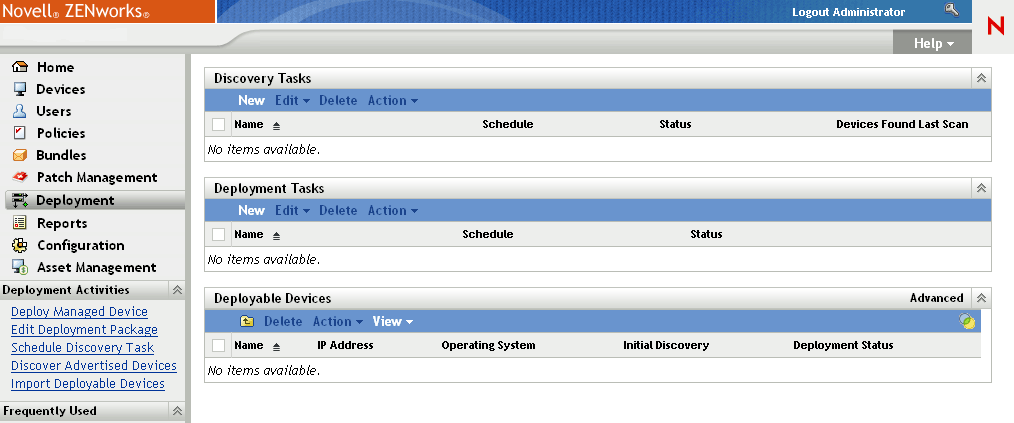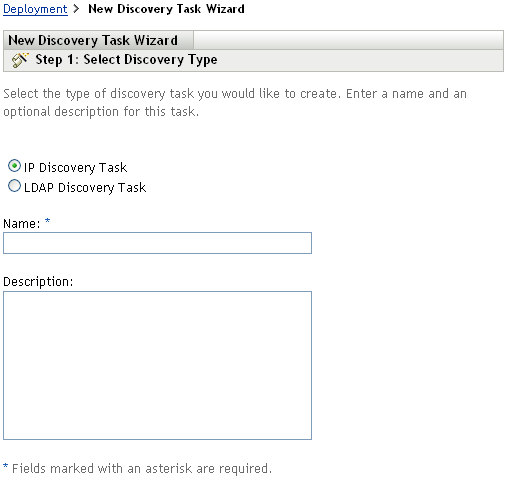2.3 Creating an IP Discovery Task
You use the Create New Discovery Task Wizard to create and schedule the tasks used by ZENworks Servers to discover devices on your network and add them to the ZENworks database.
When a discovery task runs, the ZENworks Server creates a discovery request for each IP address and discovery technology (WMI, WinAPI, MAC Address, NMAP, ZENworks, SNMP, SSH) used. For example, if you specify one IP address and use all seven discovery technologies, the ZENworks Server initiates seven discovery requests. Therefore, the more IP addresses you specify and the more discovery processes you use, the longer the discovery task takes to complete. For fastest results, you should create tasks that target smaller ranges of IP addresses and, if possible, assign different ZENworks Servers to process the tasks.
-
In ZENworks Control Center, click the tab.

-
In the Discovery Tasks panel, click to launch the New Discovery Task Wizard.

-
Complete the wizard by using information from the following table to fill in the fields.
Wizard Page
Details
Select Discovery Type page
Select .
Specify a name for the task. The name cannot include any of the following invalid characters: / \ * ? : " ' < > | ` % ~
Discovery Settings page > field
Chose whether to override the discovery settings configured at the Management Zone.
If you want to configure the settings on a device folder or a device, you must select before you can modify the settings.
Discovery Settings page >
The discovery process can utilize a variety of different technologies. When more than one technology is used, the discovery process initiates a discovery request for each technology, with all technology requests running simultaneously. This is done for each target IP address. For example, if you use MAC Address, SNMP, and WMI, the discovery process creates three requests for each target IP address. The requests are queued and run according to the setting.
If more than one technology request returns information for a discovered device, the information is merged together. In the case of conflicting information, the discovery process chooses the “best” information.
Using fewer discovery technologies reduces the time required to complete the discovery task but might also reduce the amount of information received.
For more information about each technology, see Section 1.3, IP Discovery Technologies.
Enter IP Discovery Settings page > field
To specify a range of IP addresses for the discovery task:
-
In the field, specify an IP address range using one of the following formats:
xxx.xxx.xxx.xxx: Standard dotted-decimal notation for a single address. For example, 123.45.167.100.
xxx.xxx.xxx.xxx - xxx.xxx.xxx.xxx: Standard dotted-decimal notation for a range of addresses. For example, 123.45.167.100 - 123.45.167.125.
xxx.xxx.xxx.xxx/n: Standard CIDR (Classless Inter-Domain Routing) notation. With CIDR, the dotted decimal portion of the IP address is interpreted as a 32-bit binary number that has been broken into four 8-bit bytes. The number following the slash (/n) is the prefix length, which is the number of shared initial bits, counting from the left side of the address. The /n number can range from 0 to 32, with 8, 16, 24, and 32 being commonly used numbers. For example, 123.45.167.100/24 matches all IP addresses that start with 123.45.167. When you add the IP address range to the list (see the next step), it is automatically expanded to show the range of addresses in dotted-decimal notation.
You are recommended to specify an IP address range that does not contain more than 50,000 devices. A task that has a large IP address range does not get started. For more information, see the troubleshooting scenario Discovery task remains in a pending state if it has a large IP address range.
-
To add an IP address range to the list, click .
-
(Optional) To exclude the IP subnets or address ranges from the discovery, click . The Excluded Addresses dialog box is displayed.
For more information on how to exclude the IP subnets or address ranges, see Enter IP Discovery Settings page > Excluded Addresses dialog box.
-
To add additional ranges, repeat Step 1 and Step 2.
Enter IP Discovery Settings page > Excluded Addresses dialog box
To specify the IP subnets or address ranges to be excluded from the IP discovery. These ranges are added to the ranges specified in the Management Zone, and the combined ranges are excluded while running the discovery task.
To specify the IP subnets or address ranges to be excluded from the discovery, do one of the following:
-
Manually add the IP address to be excluded:
-
In the field, enter the IP address range using one of the following formats:
xxx.xxx.xxx.xxx: Standard dotted-decimal notation for a single address. For example, 123.45.167.100.
xxx.xxx.xxx.xxx - xxx.xxx.xxx.xxx: Standard dotted-decimal notation for a range of addresses. For example, 123.45.167.100 - 123.45.167.125.
xxx.xxx.xxx.xxx/n: Standard CIDR (Classless Inter-Domain Routing) notation. With CIDR, the dotted decimal portion of the IP address is interpreted as a 32-bit binary number that has been broken into four 8-bit bytes. The number following the slash (/n) is the prefix length, which is the number of shared initial bits, counting from the left side of the address. The /n number can range from 0 to 32, with 8, 16, 24, and 32 being commonly used numbers. For example, 123.45.167.100/24 matches all IP addresses that start with 123.45.167. When you add the IP address range to the list (see the next step), it is automatically expanded to show the range of addresses in dotted-decimal notation.
-
To add an IP address range to the list, click .
-
-
Use a CSV file to import an IP address to be excluded:
-
In the list, click .The Import CSV File dialog box is displayed.
-
Click o browse for and select a file that contains a comma-separated or columnar list of IP addresses.
-
Click .
-
Enter IP Discovery Settings page > field
In order for the SSH, WMI, WinAPI, and SNMP discovery technologies to retrieve information from devices, you must provide credentials that the discovery technologies can use. The NMAP, MAC Address, and ZENworks technologies do not require credentials.
Unless you save the credentials, they are stored only in memory. Saved credentials are encrypted in the database for increased security.
Credentials that are not saved are cleared from memory when the ZENworks Server is restarted. If you are creating a scheduled deployment task, you might want to save the credentials to ensure that they are still available when the deployment is performed.
Enter IP Discovery Settings page > field
Not all technologies use the same credentials, and all devices might not have the same credentials, so you might need to specify multiple credentials to cover all targeted devices and to utilize all discovery technologies.
To add a credential:
-
In the Credentials panel, click to display the Enter Credential Information dialog box.
-
In the field, select the type of credentials you are defining:
General: Specifies credentials to be used by all discovery technologies except for SNMP.
Linux: Specifies credentials for the SSH technology to communicate with the SSH server on a Linux device.
Windows: Specifies credentials for the WMI and WinAPI technology to access the WMI service and Windows registry on a Windows device.
SNMP: Specifies community strings for the SNMP technology to access the SNMP service on a device. By default, the discovery process uses public as the community string.
-
If you selected , , or , fill in the username and password.
You can enter the username for Windows devices in of the following formats:
- username
- domain_name\username
- username@domain_name
- username@fully_qualified_domain_name
NOTE:Windows Server 2008 does not support the username @domain_name format.
-
If you selected , fill in a community string.
-
Click to add the credentials to the Credentials panel.
-
Repeat Step 1 through Step 5 to add additional credentials.
If you add multiple credentials of the same type (for example, multiple Windows credentials), the technologies that require those credentials use them in the order they are displayed in the Credentials panel, moving from top to bottom. Therefore, you should make sure that you place the most common credentials first in order to speed up the discovery process.
Set the Discovery Schedule page
Choose whether you want the task to run as soon as it is created (the option) or if you want to schedule the task to run at a future date and time. If you select , choose one of the following schedules:
No Schedule: Indicates that no schedule has been set. The task does not run until a schedule is set or it is manually launched. This is useful if you want to create the task and come back to it later to establish the schedule or run it manually.
Date Specific: Specifies one or more dates on which to run the task.
Recurring: Identifies specific days each week, month, or a fixed interval on which to run the task.
See Section B.0, Schedules or click the button for more information on the schedules.
Select Primary Server page > Primary Server field
Select the ZENworks Server that you want to perform the discovery task.
If you are using any Windows-specific discovery technologies (WMI, WinAPI), you must select a ZENworks Server on Windows (not Linux) or you must have already designated a Windows ZENworks Server as a discovery proxy for your Linux servers. For information on discovery proxies, see Section 2.2, Designating a Discovery and Deployment Proxy Server.
Select Windows Proxy page > field
Select this option if you want to override the Windows Proxy settings configured at the Management Zone in order to modify the settings of a task.
A Windows Proxy is primarily used for Linux Primary Servers that cannot perform discovery tasks that use Windows-specific discovery technologies (such as WMI, WinAPI, and SNMP). However, you can also use a Windows Proxy for Windows Servers if you want to discover devices in a different subnet than the Primary Server.
In order to protect information, such as a discovery credential, that is passed between the ZENworks Server and the Windows Proxy, the connection between the ZENworks Server and the Windows Proxy is secured through SSL.
Select Windows Proxy page > > field
Select this option if you want to use a Windows Proxy instead of the Windows Primary Server to perform the discovery tasks.
Discovery through WMI, WinAPI and SNMP requires certain ports to be reachable on the target devices, so the Primary Server can send Remote Registry, WMI, or SNMP requests to the target devices. Ports are opened by adding them as an exception in the Windows Firewall configuration settings. By default, the scope of the exception applies only to the local subnet. If the target device is in a different subnet than the Primary Server from which the discovery is run, you need to add the IP address of the Primary Server as an exception. However, if you use a Windows Proxy in the same subnet as a target device, you do not need to change the scope of the Windows Firewall exception.
Windows Proxy: Select the managed Windows device (server or workstation) on which you want to perform discovery tasks on behalf of Linux Primary Servers or Windows Servers.
Windows Proxy Timeout: Specify the number of seconds you want the ZENworks Server to wait for a response from the Windows Proxy.
When you finish the wizard, the discovery task is added to the list in the Discovery Tasks panel. You can use the panel to monitor the status of the task. As devices are discovered, they are listed in the Deployable Devices panel. If you have specified IP addresses to be excluded from a discovery task, then the discovery is not run for those IP addresses and the excluded IP addresses are not included in the tab.
-